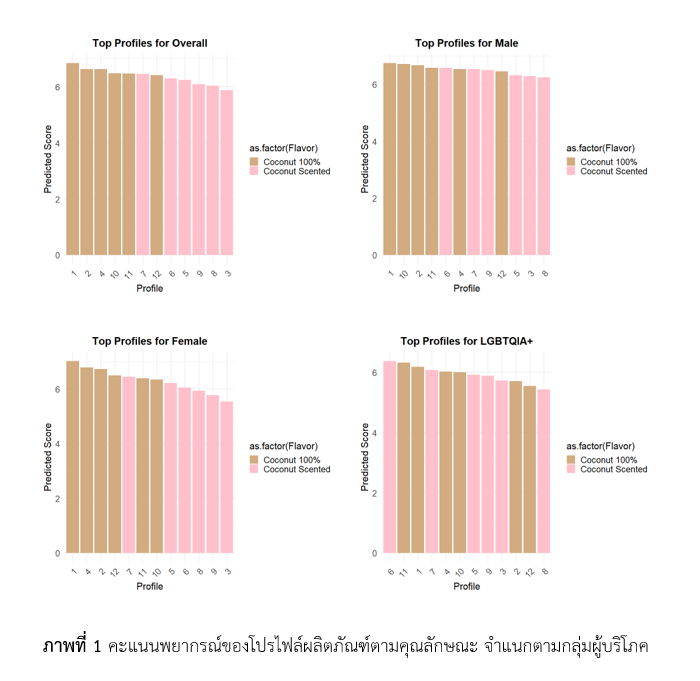Analysis of Factors Influencing the Preference for Thai-Fusion Ice Cream Using Conjoint Analysis
Main Article Content
Abstract
This study aims to 1) examine the significance of utility and various attributes, including flavor, toppings, packaging, and price, on consumer preferences for Thai-fusion coconut ice cream and 2) develop a predictive model for product design that aligns with consumer preferences. A quantitative research methodology was employed, targeting 400 Thai adolescents in Bangkok using Conjoint analysis techniques. The findings revealed that flavor (48.47%) was the most influential factor overall, followed by packaging (26.42%). Products featuring 100% coconut milk flavor and served in kraft paper cups received the highest preference scores. Gender-specific analysis indicated that female participants prioritized flavor and toppings (44.03% and 30.30%, respectively), while sexual and gender minority (LGBTQIA+) participants greatly emphasized packaging (52.54%). The predictive model suggested combining 100% coconut milk flavor with Lod Chong toppings and kraft paper cup packaging significantly enhanced preference scores. However, higher pricing led to a reduction in preference. This study highlights the importance of designing products that reflect Thailand’s cultural identity and tailoring marketing strategies to specific target groups to enhance market competitiveness.
Article Details
References
กรมกิจการเด็กและเยาวชน. (2567, ตุลาคม 1). แผนปฏิบัติราชการประจำปี 2567 (โดยใช้งบประมาณรายจ่าย พ.ศ. 2566 ไปพลางก่อน). https://www.dcy.go.th/publication/1640084008919.
ชิตพิชา แก่นทับทิม. (2566). ปัจจัยส่วนประสมทางการตลาดที่ส่งผลต่อการตัดสินใจซื้อเครื่องดื่มร้านเอสพีวาย คาเฟ่@ตลาดน้อยของวิทยาลัยสารพัดช่างสี่พระยา สาขาเอี่ยมลออ. วารสารวิชาการและวิจัย มทร.พระนคร สาขามนุษยศาสตร์และสังคมศาสตร์, 8(2), 92-108.
ชุลีกร เทพบุรี, ธัญญ์ธิชา ศรีคำ, นภัสสร แซ่ลิ้ม, ศุภชัย เหมือนโพธิ์ และวทัญญู รัศมิทัต. (2562). ปัจจัยที่ส่งผลต่อการตัดสินใจเลือกใช้บรรจุภัณฑ์เพื่อสิ่งแวดล้อมของผู้ประกอบการรายย่อย. วารสารมนุษศาสตร์และสังคมศาสตร์ มหาวิทยาลัยเอเชียอาคเนย์, 3(1), 50-58.
ณัฐชา วงศ์ศรีบุปผชาติ และณฐา ธรเจริญกุล. (2566). ปัจจัยที่มีผลต่อการตัดสินใจซื้อสินค้าที่ใช้บรรจุภัณฑ์เพื่อสิ่งแวดล้อมของผู้บริโภคในกรุงเทพมหานคร. วารสารรามคำแหง ฉบับบัณฑิตวิทยาลัย, 6(3), 77-90.
นภัสวรรณ วงกตวรินทร์. (2564). ปัจจัยที่ส่งผลต่อการซื้อผลิตภัณฑ์อาหารที่ใช้บรรจุภัณฑ์สีเขียว[วิทยานิพนธ์มหาบัณฑิต]. มหาวิทยาลัยมหิดล.
บรกรณ์ ทาสอน. (2563). ปัจจัยที่มีผลต่อพฤติกรรมการซื้อเบเกอรี่แบบ Take Away ของกลุ่มนักศึกษาในเขตจังหวัดสมุทรปราการ. วารสารร่มพฤกษ์ มหาวิทยาลัยเกริก, 38(2), 128-138.
วรงค์ ภู่ระหงษ์. (2565). ปัจจัยที่มีอิทธิพลต่อพฤติกรรมการบริโภคขนมอบของผู้บริโภคในเขตกรุงเทพมหานคร. Journal of Roi Kaensarn Academi, 7(4), 266-279.
ศรโสภฬณห์ พิมพะสาลี และเปรมฤดี จิตรเกื้อกูล. (2566). การวิเคราะห์องค์ประกอบร่วมและความตั้งใจซื้อสินค้าข้าวเกษตรอินทรีย์แปรรูปอบกรอบของผู้บริโภค. วารสารศิลปศาสตร์และวิทยาการจัดการ, 10(1), 92-108.
สำนักงานนโยบายและยุทธศาสตร์การค้า. (2567, มีนาคม 21). ไอศกรีมไทยฮอตรับซัมเมอร์ ไทยยืนหนึ่งในเอเชีย. https://tpso.go.th/news/2403-0000000017.
สำนักบริหารการทะเบียน กรมการปกครอง. (2567, พฤศจิกายน 1). สถิติประชากรทางการทะเบียนราษฎร. https://stat.bora.dopa.go.th/stat/statnew/statMONTH/statmonth/#/displayData.
Bajaj, A. (1999, December). Conjoint analysis: a potential methodology for IS research [Proceedings]. Americas Conference on Information Systems (AMCIS). Milwaukee, United States.
Dependable Food. (2023, November 10). exploring global food trends: insights into the diverse palates of the industry. https://dependablefood.com/insights/exploring-global-food-trends-insights-into-the-diverse-palates-of-the-industry.
Dlamini, N. N., Mayhew, E. J., & Nolden, A. A. (2024). unpacking consumer preferences: perceptions and sustainability of packaging material for orange juice. Sustainability, 16(14), 6202.
Hair, J. F., Black, W. C., Babin, B. J., Anderson, R. E., & Tatham, R. L. (2006). Multivariate Data analysis (6th edition). Pearson Prentice Hall.
Jain, P., & Hudnurkar, M. (2022). Sustainable packaging in the FMCG industry. Cleaner and Responsible Consumption, 7, 100075.
Krejcie, R. V., & Morgan, D. W. (1970). Determining sample size for research activities. Educational and Psychological Measurement, 30(3), 607-610.
Lyly, M., Roininen, K., Honkapää, K., Poutanen, K., & Lähteenmäki, L. (2007). Factors influencing consumers’ willingness to use beverages and ready-to-eat frozen soups containing oat β-glucan in Finland, France, and Sweden. Food Quality and Preference, 18(2), 242-255.
Ong, A. K. S., Prasetyo, Y. T., Libiran, M. A. D. C., Lontoc, Y. M. A., Lunaria, J. A. V., & Macalalad, J. A. A. (2021). Consumer preference analysis on attributes of milk tea: A conjoint analysis approach. Foods, 10(6), 1382.
Orme, B. K. (2009). Getting Started with Conjoint Analysis: Strategies for Product Design and Pricing Research (2nd ed.). Research Publishers, LLC.
R Core Team. (2023, December 1). R: A language and environment for statistical computing. R Foundation for Statistical Computing, Vienna, Austria. https://www. R-project.org/.
Rao, V. R. (2014). Applied Conjoint Analysis Springer-Verlag Berlin Heidelberg.
Rovinelli, R. J., & Hambleton, R. K. (1977). On the use of content specialists in the assessment of criterion-referenced test item validity. Dutch Journal of Educational Research, 2(2), 49-60.
Silayoi, P., & Speece, M. (2007). The importance of packaging attributes: a conjoint analysis approach. European journal of marketing, 41(11/12), 1495-1517.


